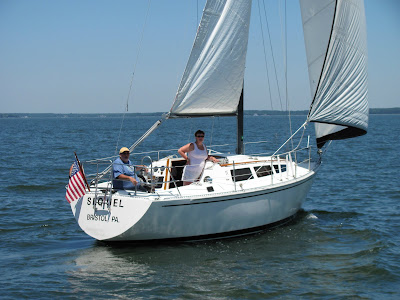
The first sail of the season was on Sunday. We left Cambridge in mid morning and sailed about 13 miles west, tacking into a northwest wind, making between 2 and 5 knots until, close to the south tip of Tilghman Island, the wind faltered, our sails fluttered and, shortly, we turned on the engine.
Ours was better luck than our friends, the Morrisons, whose boat Chautauqua wouldn't go forward once they'd backed out of their slip. Around noon, I began calling them on the radio, trying to figure out where they were on the water. We had planned to rendezvous with them and another couple on Trippe Creek, east of Oxford, where we would anchor for the night.
But as I was calling Chautauqua, I got a call on channel 16 from the vessel Sequel . I responded, letting the caller know that while the boat name seemed familiar, I had no clue who was calling.
Later, we learned that the Morrisons were still in port. That was shortly before we turned to head back to our slip. But just about then we saw a white sloop approaching us from the east.
It was Sequel, and I recognized the boat and its occupants, Mark and Rita, by sight at some distance.
We got some good photos of them and their boat, and then+ we motored back to Cambridge.
By the time we were docked, John Morrison had figured out his problem: A fouled propeller. In a shortie wet suit, he had descended into the marina water and scraped a winter's worth of scum and barnacles from the prop blades, and today he and Fran went out for a successful jaunt on the Choptank.
As for Robin, after enduring weeks of my carpentry, she passed inspection when Monica boarded.
Next up: A fresh coat of paint for Robin's entire interior.
Ours was better luck than our friends, the Morrisons, whose boat Chautauqua wouldn't go forward once they'd backed out of their slip. Around noon, I began calling them on the radio, trying to figure out where they were on the water. We had planned to rendezvous with them and another couple on Trippe Creek, east of Oxford, where we would anchor for the night.
But as I was calling Chautauqua, I got a call on channel 16 from the vessel Sequel . I responded, letting the caller know that while the boat name seemed familiar, I had no clue who was calling.
Later, we learned that the Morrisons were still in port. That was shortly before we turned to head back to our slip. But just about then we saw a white sloop approaching us from the east.
It was Sequel, and I recognized the boat and its occupants, Mark and Rita, by sight at some distance.
We got some good photos of them and their boat, and then+ we motored back to Cambridge.
By the time we were docked, John Morrison had figured out his problem: A fouled propeller. In a shortie wet suit, he had descended into the marina water and scraped a winter's worth of scum and barnacles from the prop blades, and today he and Fran went out for a successful jaunt on the Choptank.
As for Robin, after enduring weeks of my carpentry, she passed inspection when Monica boarded.
Next up: A fresh coat of paint for Robin's entire interior.
